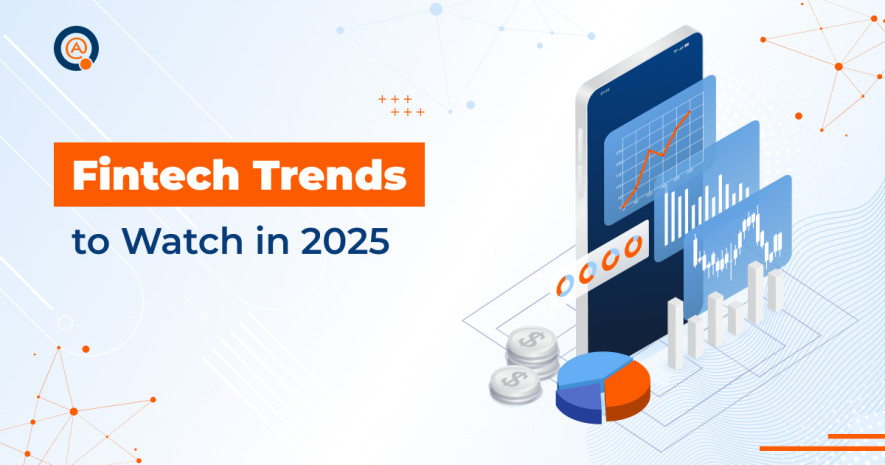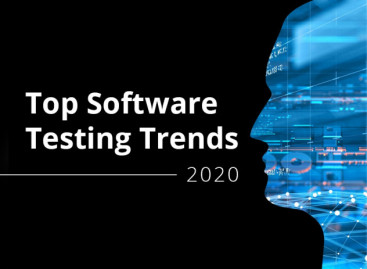- QATestLab Blog >
- QA Basics >
- Types of Software Testing >
- Blockchain Testing >
- Fintech Trends to Watch in 2025
The fintech industry is rapidly evolving as a result of advances in technology and changes in consumer behavior. Key trends emerging in this field will shape significant industry shifts in 2025. Over the next 12 months, these changes can be your valuable guidance to robust product development and update planning. Let’s dive deeper into them and explore their impact.
Which Fintech Trends Are Worth Watching in 2025?

1. Open banking will focus on the exchange of financial information. Thanks to the APIs available, account holders will be able to share their data securely with many other financial institutions, and third-party service providers will be able to exchange data with their customers.
2. Intelligent automation will open up new opportunities for financial companies to provide faster, more cost-effective, and more accurate services. According to a Deloitte report, the combination of organizational excellence, automated approach, and robotics can deliver an overall productivity increase of 20-25% within a year. Automation reduces process latency and downtime across time zones. This enables workload balancing, ensuring high financial service standards and enhancing the reputation of organizations.
3. Generative AI models will be used in a variety of fintech solutions. They perform tasks such as fraud prevention, asset management, and credit scoring. As generative AI’s capabilities expand, financial services organizations will be able to apply them to an increasing number of scenarios. AI-powered advisors are already one of the fastest-growing fintech trends, and the utility, accuracy, and use cases for such tools will only increase. These advisors will assess users’ spending patterns and financial goals to provide them with personalized recommendations across budgeting, investing, and debt management.
4. While blockchain technology is not new, it is still on the rise as an integral part of fintech products. Its attributes of transparency and security have made it an absolute necessity for online financial procedures. In 2025, this outstanding feature will be used by the financial and banking, healthcare and medical, energy, entertainment and media, and real estate industries.
5. Buy Now Pay Later (BNPL) features, such as credit scoring and tracking repayments, are expected to grow in 2025 and reshape consumer finance. By offering solutions such as BNPL, companies can improve the customer journey, meet the growing demand for alternative payment options, and ultimately drive more sales.
6. Embedded finance will be driven by non-financial brands’ integration of banking, payments, and credit into their customer journeys. This trend will result in the creation of new revenue streams for businesses as financial services become an integral part of their ecosystems.
7. Decentralized Finance (DeFi) will unlock a world of open, inclusive, and transparent financial systems. Expect to see developments in lending, borrowing, and yield farming, with a focus on scalability and regulatory compliance. The leader companies will refine their models, improve the user experience, and expand the range of assets available for borrowing and lending.
8. By 2025, the adoption of Central Bank Digital Currencies (CBDCs) is expected to expand, with countries collaborating on cross-border payment initiatives. Private fintech players are developing digital wallets and infrastructure to support these initiatives, while the International Monetary Fund (IMF) and Bank for International Settlements (BIS) are actively studying the impact of CBDCs on global finance.
9. Super apps are consolidating services across different industries and are becoming an integral part of users’ daily lives. Companies that have embraced this innovation are showcasing its potential, seamlessly integrating services like payments, ride-hailing, and more to create a unified, convenient experience.
10. We will also see an increase in the adoption of digital and contactless payments. Businesses that use this solution will be more popular, offering convenience and security to users. In fact, 48% of businesses now allow customers to pay with mobile wallets. This shows that the shift to digital payments is taking hold.
Tips to Implement Fintech Trends Wisely
To achieve success, these trendy fintech solutions require rigorous testing to deliver optimal outcomes. As a Product Growth Advisor of a top international testing company, I bring extensive expertise in ensuring the quality, reliability, and performance of innovative fintech products. I’ve compiled a set of essential software tests to check these cutting-edge solutions.

Test Functionality
Functional testing aims to verify that the application works correctly. This involves verifying that:
- AI-driven financial advisory features (e.g., budgeting, investing, and debt management) align with user inputs and objectives.
- Intelligent automation processes (e.g., parallel validations and calculations) work seamlessly.
- Buy Now Pay Later (BNPL) features, including credit assessments, payment schedules, and repayment tracking, function as intended.
- Payment journeys are smooth across various methods, such as account-to-account (A2A) transactions, credit cards, and local payment options.
Evaluate Performance
Performance testing of the fintech services evaluates and verifies the system’s speed of operation, scalability, and stability. It helps to confirm that:
- Blockchain throughput and transaction finality remain consistent and reliable across varying network conditions.
- Real-time payment systems process transactions accurately and efficiently, even under high-volume conditions.
Conduct Regression Testing
Regression testing aims to confirm that a recent change in the product has not affected existing functionality. It guarantees that:
- Updates to BNPL features, such as credit scoring algorithms or repayment tracking, do not influence the user experience.
- Changes to automation workflows don’t disrupt existing processes.
Examine Usability
By testing the UI/UX of your fintech platform, you can check whether the software is appropriate, understandable, and friendly to end-users. It ensures:
- Platforms offer a user-friendly experience for features such as AI-driven advisory, embedded finance, and real-time payments.
- BNPL process guarantees a seamless and intuitive customer experience.
- Embedded finance features enhance the user experience without complicating the core application.
- DeFi processes are intuitive and accessible for users.
- Automation tools are user-friendly and improve service delivery.
Run Integration Testing
Integration testing requires the verification of the integrated modules, both individually and in combination. It ensures:
- AI-powered assistants, like chatbots, integrate smoothly with other systems, such as investment platforms, financial databases, or payment systems.
- Integrating third-party services, APIs, and external systems like banks, payment gateways, and insurers within the super app is seamless and secure.
- Blockchain platforms interact efficiently with traditional financial systems.
- Seamless embedding of financial services into third-party apps and platforms.
Check Localization
With localization testing, you evaluate products from both a linguistic and cultural perspective to ensure that they are suitable for the target region or country. This involves verifying that:
- Your fintech platform resonates with diverse users globally by validating local currencies, languages, and regulations as part of open banking and embedded finance expansion.
Evaluate Accessibility
Fintech app accessibility testing identifies and eliminates barriers that prevent users with limited abilities from using the software. Thanks to this, you can be sure that:
- Implemented AI tools are usable for people with disabilities.
Final words
Well, the coming year promises a wave of innovative solutions for the fintech industry. Don’t wait – leverage the top trends of 2025 to enhance your product and stay ahead in the competitive market! To fully unlock the potential of these innovations, rigorous testing will be essential to ensure seamless functionality, uncover hidden vulnerabilities, and deliver a flawless user experience that builds trust and drives adoption. As a top QA company, we provide comprehensive quality assurance solutions to guarantee these innovations, helping your fintech business achieve excellence. Leave a message to get started with testing your product!

Learn more from QATestLab
Related Posts:
- No Related Posts
About Article Author
view more articles







